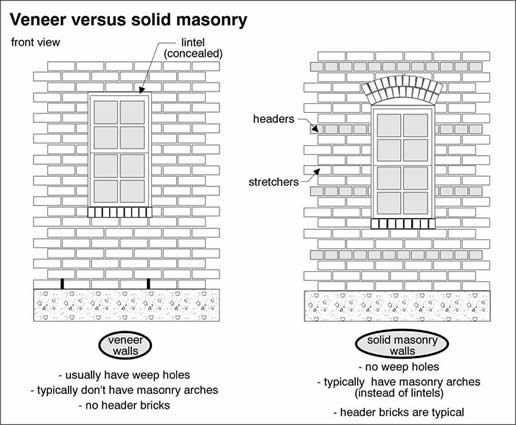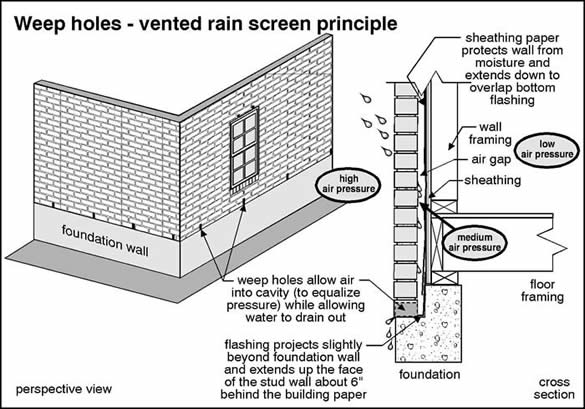SOLID MASONRY VS. BRICK VENEER
While this issue is not at the center of the unity debate, we in Pennsylvania should realize that Americans in the rest of this country think we're a little nuts because of our fixation with brick houses. Our theory is that people in Pittsburgh were raised on stories like the "Three Little Pigs." We want a house that nobody can huff and puff and blow down.
There's Brick, and Then There's Brick
What most people in Pennsylvania don't realize is that there are two very different types of brick houses, brick veneer and solid masonry.
Solid Masonry
Solid masonry construction is also called "Solid Brick," "Double Brick" and sometimes "Brick and Block." In its most common form, a solid masonry wall consists of an outer layer of brick and an inner layer of brick (a layer of brick is called a "wythe" in masonry circles).
The reason why solid masonry is a more accurate description than solid brick or double brick is because the inner wythe may not be brick. Because the inner wythe will never be seen, concrete or cinder block is sometimes substituted for brick.
As a brick wall increases in height, there is more and more danger that the inner wythe will separate from the outer wythe. To hold the two wythes together, header bricks are installed, usually every six rows. From the outside, header bricks look like regular bricks except they are shorter. In reality, they are the same size as a normal brick; however they are installed sideways so that the end of the brick is visible from the exterior of the building. The header bricks act as a bridge between the outer wythe and the inner wythe and prevent the two from separating.
Therefore, most solid masonry walls display header bricks in every 6th row or course. Sometimes, every brick in the course is a header brick; however there are a number of common patterns. It is not unusual to see two long bricks followed by two short ones then two long ones then two short ones. (The long bricks, by the way, are called stretchers.)
Sometimes bricks are installed over windows with their long face parallel to the wall but the brick standing on its end. These are called soldiers.
It is possible to build a solid masonry wall using metal ties to hold the two wythes of masonry together. When this is done, no header bricks will be visible and the wall can easily be mistaken for a brick veneer wall.

What's So Good About A Solid Masonry Wall?
There is no question that the big bad wolf will find this wall the hardest to blow down. Structurally, solid masonry walls are very strong and can, if properly maintained, provide hundreds of years of service.
What Is Brick Veneer?
If solid masonry is so good, why is it that most brick houses built in the last 30 years are brick veneer construction?
Firstly, we have to understand the difference between brick veneer and solid masonry. The biggest difference is that with solid masonry, the brick is holding up the house. With brick veneer, the house is holding up the brick!
When we say brick veneer, we don't mean those little thin slices that you glue on your kitchen wall. We mean an honest to goodness brick. However, the wall is only one wythe thick. Behind the brick veneer is a wood frame wall which is actually holding up the house. The brick veneer is, in effect, siding!
INSULATION
Brick veneer became the norm when building codes began to require insulation in the exterior walls. One of the best insulators is air. Most good insulation does nothing but trap air; that's why most insulations are light and fluffy. Brick is not exactly light and fluffy. Therefore it's not really a very good insulator. A brick veneer house then, is really a wood frame house where the cavity between the studs in the wall can be insulated.
The walls are built, covered with sheathing and often insulated before the brick is even installed. As the brick is being installed, metal ties are nailed onto the wood frame wall. It is important that they be nailed into the studs and not just into the sheathing. The metal ties are then bent so that they are horizontal where they become imbedded in the mortar joints as the brick veneer wall is constructed. The brick veneer is built on the outer edge of the foundation wall so that a one inch air space remains between the brick veneer and the sheathing.
HOW WATERPROOF IS BRICK?
The short answer is "not very." With a wind driven rain, moisture will pass right through a brick wall. The one inch air space behind the brick allows this water to run down the back surface of the brick. At the bottom of the wall cavity, a plastic or metal flashing collects the water and allows it to drain out through weep holes. You'll find weep holes spaced at approximately 32 inches (every fourth brick) along the top of foundation walls and above doors and windows.

Not only do the weep holes let the water drain out of the wall, but they also allow the wind to get behind the brick and pressurize the one inch airspace between the back of the brick and the sheathing. Believe it or not, this extra air pressure reduces the amount of rain that gets forced through the wall.
SO WHICH IS BETTER?
Well, that depends on your criteria. Solid masonry walls are certainly stronger; however brick veneer walls are plenty strong and are certainly better insulated. In the big scheme of things, the differences between the two types of construction should not be important enough to affect a purchase decision. In the interests of national unity, you shouldn't even care whether the house has any brick.
Line drawings are from Carson Dunlop's Illustrated Home.
<< Back to Technical Library |